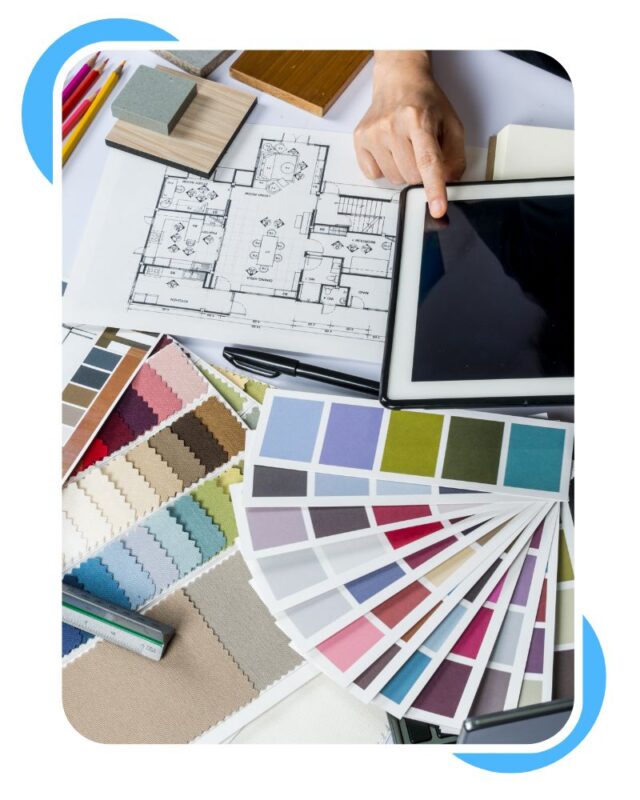
Interior design courses are educational programs that provide students with the knowledge and skills needed to design and create functional and aesthetically pleasing interior spaces. These courses cover various topics, including colour theory, space planning, furniture and accessories selection, lighting, and materials.
Several types of interior design courses are available, including online courses, certificate programs, associate degrees, bachelor’s degrees, and master’s degrees. Online courses are often self-paced and can be completed from anywhere with an internet connection. Certificate programs typically take a few months to a year to complete and provide students with a basic understanding of interior design principles.
Associate degrees in interior design typically take two years to complete and provide a more comprehensive education than certificate programs. These programs often include courses in drafting, CAD (computer-aided design), and building codes and regulations.
Bachelor’s degrees in interior design typically take four years to complete, providing students with a deeper understanding of design principles and techniques. These programs often include art and design history courses, sustainability, and advanced design techniques.
Master’s degrees in interior design typically take one to two years to complete and allow students to specialize in a particular area of interior design, such as healthcare design or sustainable design.
In addition to formal education, many interior designers gain experience through internships or apprenticeships. Internal design certification is also available through organizations like the National Council for Interior Design Qualification (NCIDQ).
Overall, interior design courses can provide students with the skills and knowledge needed to create beautiful and functional interior spaces, whether as a career or as a hobby.

How To Learn Interior Design?
There are several ways to learn interior design, including online courses, university courses, boot camps, and self-study. Each option has advantages and disadvantages, and choosing the best approach depends on your learning style, budget, and goals.
Online courses
Online courses are a popular option for learning interior design as they are flexible and can be completed at your own pace. Online courses can be found through various platforms and providers, ranging from free resources to paid courses with accredited certifications. These courses typically cover the fundamentals of interior design, including colour theory, furniture selection, and space planning.
University courses
University courses are a more traditional approach to learning interior design and provide a structured education with access to instructors and peers. University courses often provide a more comprehensive education, covering a wider range of topics and offering hands-on experience through projects and internships. These programs can range from certificate to bachelor’s and master’s degrees.
Bootcamps
Bootcamps are intensive, short-term programs that provide focused instruction on specific topics or skills. Interior design boot camps can cover topics like lighting design or sustainable design and are often led by industry professionals. These programs can be completed in just a few weeks or months, providing students with a focused and practical education.
Self-study
Self-study is also an option for learning interior design and can involve reading books, watching videos, or experimenting with design projects on your own. While self-study can be a cost-effective option, it may provide a different level of education or feedback than other options.
Ultimately, the best approach to learning interior design depends on your preferences and goals. It may be helpful to research and explore different options before deciding.

Benefits of Learning Interior Design:
Learning interior design can offer many benefits, both personal and professional. Here are some of the key benefits of learning interior design:
Creative Outlet
Interior design allows individuals to express their creativity and imagination. It allows the creation of beautiful and functional spaces that reflect personal style and taste.
Career Opportunities
Interior design is a growing industry, with many opportunities for employment in areas such as residential design, commercial design, hospitality design, and more. By learning interior design, individuals can pursue a career in a field they are passionate about.
Increased Property Value
A well-designed interior space can increase the value of a property, making it more attractive to potential buyers or renters. By learning interior design, individuals can create areas that are not only beautiful but also functional and valuable.
Cost Savings
Individuals can save money on hiring professional designers by learning how to design and decorate their own spaces. They can also make informed decisions when purchasing furniture and decor, saving costs over time.
Environmental Impact
Interior design significantly impacts the environment, from the materials used to the energy consumption of space. By learning sustainable design practices, individuals can reduce the environmental impact of their interior spaces and contribute to a more sustainable future.
Personal Satisfaction
Designing a space can be a fulfilling and satisfying experience, allowing individuals to create a space tailored to their needs and preferences. It can also provide a sense of accomplishment and pride in a well-done job.
Overall, learning interior design can provide individuals with various personal and professional benefits, from increased creativity to career opportunities and cost savings.

Career After Learning Interior Design
After learning interior design, individuals can pursue various careers in the field, including:
Residential Interior Designer
Residential interior designers work with individual homeowners to create functional and aesthetically pleasing interior spaces. They may be responsible for selecting furniture and decor, creating layouts, and managing construction or renovation projects.
Commercial Interior Designer
Interior designers work on projects in commercial settings, such as offices, retail spaces, and restaurants. They may be responsible for designing functional and efficient spaces for employees and customers while also meeting aesthetic and branding requirements.
Hospitality Interior Designer
Interior designers work on projects in the hospitality industry, including hotels, resorts, and spas. They may be responsible for creating spaces that are welcoming and comfortable for guests while also meeting the functional and aesthetic needs of the business.
Set Designer
Set designers work in film and television, designing and creating sets for movies, television shows, and commercials. They may be responsible for creating realistic and immersive environments that help tell the story of the production.
Event Designer
Event designers work on projects such as weddings, corporate events, and parties, creating memorable and visually appealing spaces for guests. They may be responsible for selecting decor, furniture, lighting, and other elements that make a cohesive theme and atmosphere.
Self-employed Interior Designer
Individuals who learn interior design can also choose to start their own business as freelance interior designers or consultants. This can provide flexibility and the opportunity to work on various projects while being their boss.
Overall, learning interior design can provide individuals various career options in a growing industry.

Salary After Learning Interior Design in India
The salary after learning interior design in India can vary depending on experience, location, employer, and industry. Here are some estimates of the salary ranges for interior designers in India:
Entry-level Interior Designer
The average salary for an entry-level interior designer in India is around Rs. 2-4 lakhs per annum.
Mid-level Interior Designer
The average salary for a mid-level interior designer with 5-10 years of experience is around Rs. 5-8 lakhs per annum.
Senior-level Interior Designer
The average salary for a senior-level interior designer with more than 10 years of experience is around Rs. 10-20 lakhs per annum.
Self-employed Interior Designer
The salary for a self-employed interior designer can vary widely depending on their client base, project scope, and reputation in the industry. However, experienced and successful self-employed interior designers can earn significantly higher salaries than those working for employers.
It’s important to note that these estimates are just averages, and salaries can vary widely based on individual circumstances. The salary ranges can also vary depending on location in India, with metropolitan areas typically offering higher salaries than smaller cities or towns.

How to Succeed in an Interior Design Filled
To succeed in the interior design field, here are some tips:
Build a Strong Portfolio
A portfolio is a collection of your best work that showcases your design skills and style. A strong portfolio can help you stand out to potential clients or employers and demonstrate your capabilities as a designer.
Keep Up with Industry Trends
The interior design industry is constantly evolving, and staying up-to-date with the latest trends and technologies is essential. This can help you create fresh, innovative designs that appeal to clients and set you apart from competitors.
Develop Strong Communication Skills
As an interior designer, you must communicate effectively with clients, contractors, and other professionals in the industry. Strong communication skills can help you build relationships, clarify expectations, and understand and execute your vision correctly.
Network
Building a solid professional network can help you establish connections with potential clients, employers, and industry professionals. Attend industry events, join professional organizations, and reach out to other designers and professionals in the industry to build relationships and gain exposure.
Stay Organized
Interior design projects can involve multiple tasks, timelines, and stakeholders, so it’s important to stay organized and track all the details. This can help you meet deadlines, manage client expectations, and deliver high-quality work.
Embrace Feedback
Constructive feedback can help you improve your skills and grow as a designer. Embrace client, employer, and colleague feedback and use it to learn and improve your work.
Overall, succeeding in the interior design field requires a combination of technical skills, creativity, and strong communication and organizational abilities. By following these tips and continuously developing your skills and knowledge, you can establish yourself as a successful interior designer.
Common Challenges in Learning Interior Design
Learning interior design can be both exciting and challenging. Some common challenges that learners may face while studying interior design include the following:
Technical Skills
Interior design involves various technical skills, including drafting, rendering, and computer-aided design (CAD). Learners may find it challenging to master these skills, particularly if they have limited experience with design software or technical drawing.
Design Principles
Interior design requires a deep understanding of colour theory, proportion, and scale. Learners may need help to apply these principles in their work or find it challenging to develop a personal style that reflects their creative vision.
Time Management
Interior design projects often involve multiple tasks and deadlines, and learners may need help managing their time effectively. This can lead to stress and poor-quality work if not appropriately handled.
Keeping Up with Trends
The interior design industry is constantly evolving, and learners may find it challenging to stay up-to-date with the latest trends, technologies, and design techniques.
Client Management
Interior designers often work with clients, and learners may find it challenging to manage client expectations, communicate effectively, and negotiate project details.
Budget Constraints
Interior design projects often have budget constraints that learners must work within. This can require creative problem-solving and balancing design considerations with financial limitations.
Overall, learning interior design can be challenging. Still, by developing technical skills, understanding design principles, and practising effective time management and communication, learners can overcome these challenges and develop successful careers.

Advantages and Disadvantages of Interior Design.
Advantages of Interior Design
1. Enhances Aesthetics: Interior design can transform a space and enhance aesthetics by creating a visually appealing environment that reflects the client’s personality and preferences.
2. Improves Functionality: Interior design can improve the functionality of a space by optimizing its layout and organization. This can improve traffic flow, increase efficiency, and enhance user experience.
3. Increases Property Value: A well-designed interior can increase the value of a property by making it more attractive to potential buyers or tenants.
4. Creates Personalized Spaces: Interior design allows individuals to create personalized spaces that reflect their unique style, preferences, and needs. This can improve the comfort and livability of a room.
5. Promotes Sustainability: Interior designers can incorporate sustainable design practices and materials into their work, reducing environmental impact and promoting a healthier living environment.
Disadvantages of the Interior Design
1. Cost: Interior design services can be expensive, especially if clients want a high-end, customized design. This can be a barrier for some people needing more money to hire a professional interior designer.
2. Time: Interior design projects can be time-consuming, mainly if the project involves a major renovation or construction. This can disadvantage clients who may need more time or patience to wait for the project to be completed.
3. Limited Creative Control: Clients may feel they need more creative control over the design process, mainly if they hire a professional interior designer. This can be a disadvantage for individuals with strong opinions or preferences about the design of their space.
4. Maintenance: A well-designed space may require additional maintenance to keep it looking its best. This can disadvantage individuals needing more time or resources to maintain a high-end design.

FAQs Related to Interior Design
Sure, I would be happy to help! Here are some frequently asked questions related to Interior Design:
Interior design is the art and science of enhancing the interior of a space to create a functional, aesthetically pleasing environment that meets the needs and preferences of the client.
Interior designers need various skills, including creativity, technical proficiency, communication, problem-solving, and project management.
To become an interior designer, you can pursue a degree or diploma in interior design or a related field. You can also take online courses, attend boot camps or workshops, or learn through self-study.
Interior designers can work in various industries, including residential and commercial design, hospitality and tourism, set design, and event planning.
The salary for an interior designer in India can vary depending on factors such as experience, location, and the type of employer. Entry-level designers can earn between Rs. 2.5-4 lakhs per annum, while senior designers can earn upwards of Rs. 10 lakhs per annum.
You can find an interior designer through referrals, online directories, or by attending trade shows and events. It’s important to research potential designers and review their portfolios and credentials before deciding.
The duration of an interior design project can vary depending on the scope of the project and the client’s requirements. Some projects can be completed in weeks, while others can take several months or years.
Common challenges in interior design include mastering technical skills, understanding design principles, managing time and budgets effectively, keeping up with trends, and managing client expectations and communications.
